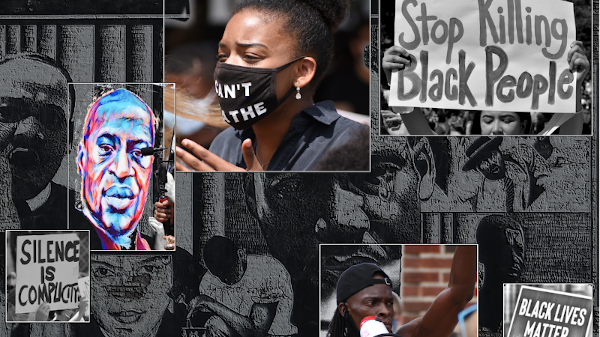
On Confederate Monuments
Download
a free PDF copy
of this article.
By John LaRoe, 21 October 2020
A friend of mine on Facebook, an actual friend whom I've known for years, has been doing a daily morning essay on his timeline for his friends since the pandemic landed.
His name is Norman, so, naturally, he's titled the series "Norm In Quarantine."
He needed to take some time off this past week and invited me to do play substitute writer for an episode. He said I could write about anything.
The resulting post, my description of and commentary on what I learned from research and gathered from experience, follows
Norm In Quarantine. 16 October 2020.

Full Disclosure: I think the righteous side won the Civil War. I am glad that the Union was preserved. I am glad that the institution of slavery was abolished.
That having been said, I don't remember being all that much disturbed by Confederate monuments and flags ... until I started noticing them. I mean, I knew that they were not a part of our history. I understood them to be false artifacts of the legendary "Lost Cause." So, yeah, I knew they were wrong. But I was, like, I dunno ...
Maybe I had just been living in the same place too long and had begun to take my surroundings for granted. Maybe I was, and still am, just that much a product of the local dominant ideology.
I just sort of assumed ...
- There probably weren't that many of them. (After all, I figured, they lost. Right?)
- They were representative of the post-Civil War era and had a sort of historic patina that somehow softened their message. (After all, I assumed, southerners probably put them up 150-plus years ago to memorialize their dead.)
But, as Norm would say, "You know what happens when you assume, John."
I was wrong on both counts.
To the first point, there are a lot of these things. Even after excluding "thousands of monuments, markers or other tributes ... on or in battlefields, museums, cemeteries and other places that are largely historical in nature," the Southern Poverty Law Center (SPLC) has catalogued 1,747 "Confederate monuments, place names and other symbols" that have been erected "both in the South and across the nation," including ...
- 780 monuments, more than 300 of which are in Georgia, Virginia or North Carolina;
- 103 public K-12 schools and three colleges named for Robert E. Lee, Jefferson Davis or other Confederate icons;
- 80 counties and cities named for Confederates;
- 9 observed state holidays in five states; and
- 10 U. S. military bases.
Wait! Whaaa?
U. S. Military bases? B-b-b-b-but these Confederate guys were literally at war with the United States. Right? Killing U.S. soldiers, sailors and Marines, right?
And we memorialize them by naming our military bases after them? Military bases on which way over a million Black humans have served? Named after men who actually, matter-of-factually fought to keep their ancestors enslaved? I-I-I ...
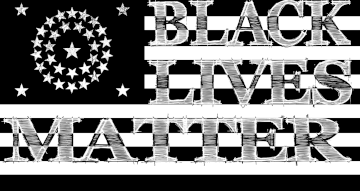
|
-- advertisement -- This and other "Black Lives Matter" designs are available on a variety of items in the Political Action Collection of the LaRoe Design Shop at the RedBubble marketplace. Shown here, the "Black Lives Matter" message emblazoned across the stripes of the 34-star, Civil War Flag of the United States of America, the winning side. |
Well, I had a hard time absorbing that.
We have (so far, at least) not named a U. S. military base after Isoroku Yamamoto, or Erwin Rommel, or Kuribayashi Tadamichi, or Gerd von Rundstedt, for reasons I hope are obvious.
So why then do we have "Fort Rucker (Gen. Edmund Rucker) in Alabama; Fort Benning (Brig. Gen. Henry L. Benning) and Fort Gordon (Maj. Gen. John Brown Gordon) in Georgia; Camp Beauregard (Gen. P.G.T. Beauregard) and Fort Polk (Gen. Leonidas Polk) in Louisiana; Fort Bragg (Gen. Braxton Bragg) in North Carolina; Fort Hood (Gen. John Bell Hood) in Texas; and Fort A.P. Hill (Gen. A.P. Hill), Fort Lee (Gen. Charles Lee) and Fort Pickett (Gen. George Pickett) in Virginia?"
Sorry. I digress. That whole naming military bases after sworn enemies of the United States really gobsmacked me.
The larger point is: 1700 monuments is an awful lot of monuments for a victorious nation to host in honor of a defeated foe ... especially when that foe was defeated in a treasonous war that it initiated against that victor.

Among states that did not actually secede from the Union, Missouri, with 13 on the SPLC's list, has the second most. (Kentucky, which also did not secede, has 24.
Even Kansas (Kansas!) had at least one, according to SPLC, a Confederate flag hoisted among several U. S. flags in their Veterans Memorial Park, until it was removed in 2015 when photographs of a mass murderer posing with a Confederate flag were publicized.
So, wow. And on to the second thing I was wrong about: these monuments were not, by and large, erected by the defeated to memorialize the dead. All but a handful (okay, I count 80, a little less than 5%) were dedicated in 1890 or later.
In the 55 years between 1890 and 1945, 721 monuments were dedicated ... and 2,891 American Blacks were lynched.
I am not saying that monuments cause lynchings or vice versa. But they overlap one another on the timeline of our past.
Sometimes they even speak to one another. One of these conversations can be found at the east end of the MKT Spur off the Katy Trail into Columbia, Mo.
It memorializes a lynching in an entirely appropriate, non-celebratory way, as history to be remembered but not romanticized, still less repeated.
It's a simple plaque commissioned in 2016 by Missouri University's Association of Black Graduate and Professional Students that recalls the lynching at the Stewart Road Bridge with this text:
Near this place James T. Scott, a Black Janitor in the medical school at MU, was killed on April 29th, 1923. A mob brought Mr. Scott to the bridge, placed a noose around his neck, and pushed him over the railing while hundreds of spectators watched. MU's presence and alleged student involvement in Mr. Scott's murder stirred public outrage and made front-page news across the U.S. Although charges were filed against leaders of the mob, none were convicted.
The text concludes by enjoining us to "continue the fight against systems of oppression" and "reflect on how to better our community for all Columbians."
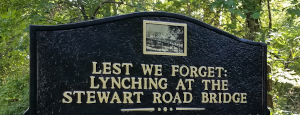
But just as that plaque, erected some 93 years after Mr. Scott was murdered, was made possible by a diverse and very different MU student population from the one "involved" in that lynching, the erection of Confederate monuments occurs in rhythm with other changes in American culture and demography, and those monuments and the lynchings fluctuated in tandem to the same sentiments and events in American history: the establishment of Confederate-focused organizations (the United Confederate Veterans, United Daughters of the Confederacy, Sons of Confederate Veterans), the founding of the National Association for the Advancement of Colored People (NAACP), Plessy v Ferguson, the re-emergence of the Ku Klux Klan.
And, while the construction of the monuments tapered off sharply following World War II, there was a resurgence in monument dedications in the late 1950s, following Brown v (Topeka) Board of Education; and that surge continued through the 60s as Civil Rights became an issue of national concern.
Monument fever tapered off through the 70s & 80s, then picked up again in the mid-1990s.
That's when Pleasant Hill's Community Betterment Association erected its bust of Hiriam Bledsoe, with complementary faux artillery piece, on or near that otherwise charming little community's town square.
Bledsoe's bust is mounted on a headstone-looking block of concrete that's covered, front and back, with text recounting his life and the exploits of the artillery battery he mustered and led throughout the war. It was, according to the concrete, "One of the Finest Artillery units of the Civil War."
I'm going to remind you, because the monument does not, that the people who were the targets of that "fine" artillery were, you know, U. S. soldiers fighting to prevent the dissolution of the U. S., while Bledsoe was fighting to dissolve it because, you know, slavery, also not mentioned in the concrete.
Of course Pleasant Hill wasn't the only American community commemorating the Confederacy in this round of monument construction and dedication. States we typically regard as "southern" dedicated 42 monuments (or named schools or renamed stretches of highways) from 1995 through 2017; but so did some others that would fall more into the WTAF category of Confederacy connections, like Massachusetts and Arizona (3 each) and New Mexico (8!) and South Dakota (5!). (I did not realize that they took the "South" in South Dakota that seriously.) Even Idaho added one.
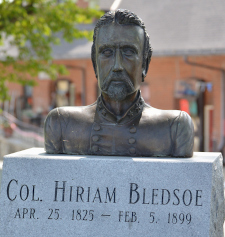
And that's not including the Bledsoe monument in Pleasant Hill.
In any case, that little memorial building boomlet peaked in 2001 with another spike in 2009, when the first Black man took the oath of office to serve as president of the United States.
That's also the year, by the way, that Pleasant Hill's Community Betterment Association expanded on its Bledsoe monument, adding a plastic covered informational poster portraying Pleasant Hill as a victim of the war (which it was) and celebrating the "Union Army veterans, former Confederate soldiers, former slaves, displaced victims of war, and newcomers from many different walks of life [who] worked together to rebuild Pleasant Hill and start again."
As the narrator remarks at the conclusion of Hemingway's The Sun Also Rises: "Isn't it pretty to think so?"
And to be sure, the creation of new Confederate memorializations has tapered off ... again ... a century and a half after the Confederacy's defeat.
And at least 114 have been removed since the massacre of nine parishioners in the Mother Emanuel church in Charleston, South Carolina (which prompted the removal of that flag in Wichita) and the more recent killings by police of George Floyd in Minneapolis and Breonna Taylor in Louisville.
But 1600 or so remain.
And 11 states have 23 Confederate holidays or observances "written into the state code," according to SPLC. Nine of those holidays, in five of those states, are paid holidays for state employees. Paid holidays.
Let that sink in.
We may be used to that, but it's not normal. And it's not okay.
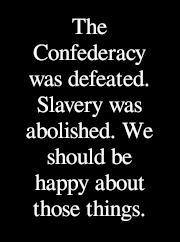
Our history is a complicated story of imperfect, mortal humans who never-the-less chose to struggle to preserve the Union when its existence was threatened by traitors fighting in the name of white supremacy and on behalf of the institution of slavery.
Monuments that perch traitors on horseback like medieval knights or mount their busts on pedestals like Roman senators and plaques that glorify their exploits without reference to the ignoble cause for which they fought or the humans they enslaved, those things preserve neither our history nor Southern heritage.
They seek instead to replace our history with the simpler fiction of a Noble Lost Cause that never was, to recast that heritage as a benign era of white rule. And in the attempt they undermine both.
That is not okay. It is not normal. The Confederacy was defeated. Slavery was abolished. We should be happy about those things. We can and should celebrate those things while acknowledging our imperfections and mortality.
Links & Credits:
"Whose Heritage? Public Symbols of the Confederacy." Report of the Southern Policy Law Center. Continuously updated.
"Lynching Statistics by Year - UMKC School of Law." Lynching in America: Statistics, Information, Images. University of Missouri - Kansas City. c. 2000
Photos by John LaRoe, 2020.
Other Readings:
The Red Record: Tabulated Statistics and Alleged Causes of Lynching in the United States. Ida B. Wells-Barnett (1862-1931). The Gutenberg Project.
Mob Rule in New Orleans: Robert Charles and His Fight to Death, the Story of His Life, Burning Human Beings Alive, Other Lynching Statistics. Ida B. Wells-Barnett (1862-1931). The Gutenberg Project.
Southern Horrors: Lynch Law in All Its Phases. Ida B. Wells. New York: New York Age Print. 1892 – via Schomburg Center for Research in Black Culture, Manuscripts, Archives and Rare Books Division, New York Public Library.
Commentary
©2020 LaRoeDotCom.
All rights reserved.
